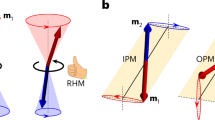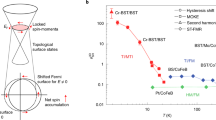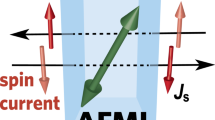Abstract
The recent demonstrations of electrical manipulation and detection of antiferromagnetic spins have opened up a new chapter in the story of spintronics. Here, we review the emerging research field that is exploring the links between antiferromagnetic spintronics and topological structures in real and momentum space. Active topics include proposals to realize Majorana fermions in antiferromagnetic topological superconductors, to control topological protection and Dirac points by manipulating antiferromagnetic order parameters, and to exploit the anomalous and topological Hall effects of zero-net-moment antiferromagnets. We explain the basic concepts behind these proposals, and discuss potential applications of topological antiferromagnetic spintronics.
This is a preview of subscription content, access via your institution
Access options
Access Nature and 54 other Nature Portfolio journals
Get Nature+, our best-value online-access subscription
$29.99 / 30 days
cancel any time
Subscribe to this journal
Receive 12 print issues and online access
$209.00 per year
only $17.42 per issue
Buy this article
- Purchase on Springer Link
- Instant access to full article PDF
Prices may be subject to local taxes which are calculated during checkout






Similar content being viewed by others
Change history
30 May 2018
In the version of this Review Article originally published, three of the citations corresponded to the wrong references. Ref. 16 should have corresponded to Nature 533, 513–516 (2016), ref. 17 to Nat. Mater. 16, 94–100 (2016), and ref. 18 to Phys. Rev. Appl. 6, 054001 (2016).
References
Sarma, S. D., Freedman, M. & Nayak, C. Majorana zero modes and topological quantum computation. npj Quant. Inf. 1, 15001 (2015).
Beenakker, C. W. J. & Kouwenhoven, L. A road to reality with topological superconductors. Nat. Phys. 12, 618–621 (2016).
Hasan, M. Z. & Kane, C. Colloquium: Topological insulators. Rev. Mod. Phys. 82, 3045–3067 (2010).
Fan, Y. & Wang, K. L. Spintronics based on topological insulators. SPIN 06, 1640001 (2016).
Wang, H. et al. Surface-state-dominated spin–charge current conversion in topological-insulator–ferromagnetic-insulator heterostructures. Phys. Rev. Lett. 117, 076601 (2016).
Soumyanarayanan, A., Reyren, N., Fert, A. & Panagopoulos, C. Spin–orbit coupling induced emergent phenomena at surfaces and interfaces. Nature 539, 509–517 (2016).
Pesin, D. A. & MacDonald, A. H. Spintronics and pseudospintronics in graphene and topological insulators. Nat. Mater. 11, 409–416 (2012).
Liang, T. et al. Ultrahigh mobility and giant magnetoresistance in the Dirac semimetal Cd3As2. Nat. Mater. 14, 280–284 (2014).
Wu, J., Liu, J. & Liu, X. J. Topological spin texture in a quantum anomalous Hall insulator. Phys. Rev. Lett. 113, 136403 (2014).
Fert, A., Cros, V. & Sampaio, J. Skyrmions on the track. Nat. Nanotech. 8, 152–156 (2013).
Burkov, A. A. Topological semimetals. Nat. Mater. 15, 1145–1148 (2016).
Felser, C. & Yan, B. Weyl semimetals: magnetically induced. Nat. Mater. 15, 1149–1150 (2016).
Šmejkal, L., Jungwirth, T. & Sinova, J. Route towards Dirac and Weyl antiferromagnetic spintronics. Phys. Status Solidi Rapid Res. Lett. 11, 1700044 (2017).
Fan, Y. et al. Magnetization switching through giant spin–orbit torque in a magnetically doped topological insulator heterostructure. Nat. Mater. 13, 699–704 (2014).
Han, J. et al. Room-temperature spin–orbit torque switching induced by a topological insulator. Phys. Rev. Lett. 119, 077702 (2017).
Katmis, F. et al. A high-temperature ferromagnetic topological insulating phase by proximity coupling. Nature 533, 513–516 (2016).
He, Q. L. et al. Tailoring exchange couplings in magnetic topological insulator/antiferromagnet heterostructures. Nat. Mater. 16, 94–100 (2016).
Finley, J. & Liu, L. Spin–orbit torque efficiency in compensated ferrimagnetic cobalt–terbium alloys. Phys. Rev. Appl. 6, 054001 (2016).
Park, J. et al. Anisotropic Dirac fermions in a Bi square net of SrMnBi2. Phys. Rev. Lett. 107, 126402 (2011).
Wang, K., Graf, D., Lei, H., Tozer, S. W. & Petrovic, C. Quantum transport of two-dimensional Dirac fermions in SrMnBi2. Phys. Rev. B 84, 220401(R) (2011).
Masuda, H. et al. Quantum Hall effect in a bulk antiferromagnet EuMnBi2 with magnetically confined two-dimensional Dirac fermions. Sci. Adv. 2, e1501117 (2016).
Richard, P. et al. Observation of Dirac cone electronic dispersion in BaFe2As2. Phys. Rev. Lett. 104, 137001 (2010).
Chen, Z.-G. et al. Two-dimensional massless Dirac fermions in antiferromagnetic AFe2As2 (A = Ba, Sr). Phys. Rev. Lett. 119, 096401 (2017).
Mong, R. S. K., Essin, A. M. & Moore, J. E. Antiferromagnetic topological insulators. Phys. Rev. B 81, 245209 (2010).
Liu, C. et al. Metallic surface electronic state in half-Heusler compounds RPtBi (R= Lu, Dy, Gd). Phys. Rev. B 83, 205133 (2011).
Wang, Z. F. et al. Topological edge states in a high-temperature superconductor FeSe/SrTiO3(001) film. Nat. Mater. 15, 968–973 (2016).
Niu, C. et al. Quantum spin Hall effect and topological phase transitions in honeycomb antiferromagnets. Preprint at https://arxiv.org/pdf/1705.07035.pdf (2017).
He, Q. L. et al. Topological transitions induced by antiferromagnetism in a thin-film topological insulator. Preprint at https://arxiv.org/pdf/1612.01661.pdf (2016).
Mogi, M. A magnetic heterostructure of topological insulators as a candidate for an axion insulator. Nat. Mater 16, 516–522 (2017).
Tokura, Y., Kawasaki, M. & Nagaosa, N. Emergent functions of quantum materials. Nat. Phys. 13, 10561068 (2017).
Xiao, D., Chang, M.-C. & Niu, Q. Berry phase effects on electronic properties. Rev. Mod. Phys. 82, 1959–2007 (2010).
Dong, X.-Y., Kanungo, S., Yan, B. & Liu, C.-X. Time-reversal-breaking topological phases in antiferromagnetic Sr2FeOsO6 films. Phys. Rev. B 94, 245135 (2016).
Burkov, A. A. & Balents, L. Weyl semimetal in a topological insulator multilayer. Phys. Rev. Lett. 107, 127205 (2011).
Yang, K. Y., Lu, Y. M. & Ran, Y. Quantum Hall effects in a Weyl semimetal: possible application in pyrochlore iridates. Phys. Rev. B 84, 075129 (2011).
Armitage, N. P., Mele, E. J. & Vishwanath, A. Weyl and Dirac semimetals in three dimensional solids. Rev. Mod. Phys. 90, 015001 (2018).
Jia, S., Xu, S.-Y. & Hasan, M. Z. Weyl semimetals, Fermi arcs and chiral anomalies. Nat. Mater. 15, 1140–1144 (2016).
Hirschberger, M. et al. The chiral anomaly and thermopower of Weyl fermions in the half-Heusler GdPtBi. Nat. Mater. 15, 1161–1165 (2016).
Ali, M. N. et al. Large, non-saturating magnetoresistance in WTe2. Nature 514, 205–208 (2014).
Soluyanov, A. A. et al. Type-II Weyl semimetals. Nature 527, 495–498 (2015).
Pletikosic, I., Ali, M. N., Fedorov, A. V., Cava, R. J. & Valla, T. Electronic structure basis for the extraordinary magnetoresistance in WTe2. Phys. Rev. Lett. 113, 216601 (2014).
Yang, B.-J. & Nagaosa, N. Classification of stable three-dimensional Dirac semimetals with nontrivial topology. Nat. Commun. 5, 4898 (2014).
Kargarian, M., Randeria, M. & Lu, Y.-M. Are the surface Fermi arcs in Dirac semimetals topologically protected?. Proc. Natl Acad. Sci. USA 113, 8648–8652 (2016).
Tang, P., Zhou, Q., Xu, G. & Zhang, S.-C. Dirac fermions in an antiferromagnetic semimetal. Nat. Phys. 12, 1100–1104 (2016).
Šmejkal, L., Żelezný, J., Sinova, J. & Jungwirth, T. Electric control of Dirac quasiparticles by spin–orbit torque in an antiferromagnet. Phys. Rev. Lett. 118, 106402 (2017).
Young, S. M. & Wieder, B. J. Filling-enforced magnetic Dirac semimetals in two dimensions. Phys. Rev. Lett. 118, 186401 (2017).
Železný, J., Wadley, P., Olejník, K., Hoffmann, A. & Ohno, H. Spin-transport and spin-torque in antiferromagnetic devices. Nat. Phys. https://doi.org/s41567-018-0062-7 (2018).
Wadley, P. et al. Electrical switching of an antiferromagnet. Science 351, 587–591 (2016).
Tian, Z. et al. Field-induced quantum metal–insulator transition in the pyrochlore iridate Nd2Ir2O7. Nat. Phys. 12, 134–138 (2016).
Wakeham, N., Bauer, E. D., Neupane, M. & Ronning, F. Large magnetoresistance in the antiferromagnetic semimetal NdSb. Phys. Rev. B 93, 205152 (2016).
Wan, X., Turner, A. M., Vishwanath, A. & Savrasov, S. Y. Topological semimetal and Fermi-arc surface states in the electronic structure of pyrochlore iridates. Phys. Rev. B 83, 205101 (2011).
Sushkov, A. B. et al. Optical evidence for a Weyl semimetal state in pyrochlore Eu2Ir2O7. Phys. Rev. B 92, 241108(R) (2015).
Borisenko, S. et al. Time-reversal symmetry breaking type-II Weyl state in YbMnBi2. Preprint at https://arxiv.org/ftp/arxiv/papers/1507/1507.04847.pdf (2015).
Chinotti, M., Pal, A., Ren, W. J., Petrovic, C. & Degiorgi, L. Electrodynamic response of the type-II Weyl semimetal YbMnBi2. Phys. Rev. B 94, 245101 (2016).
Wang, A. et al. Magnetotransport study of Dirac fermions in YbMnBi2 antiferromagnet. Phys. Rev. B 94, 165161 (2016).
Chaudhuri, D. et al. Optical investigation of the strong spin–orbit-coupled magnetic semimetal YbMnBi2. Phys. Rev. B 96, 075151 (2017).
Yang, H. et al. Topological Weyl semimetals in the chiral antiferromagnetic materials Mn3Ge and Mn3Sn. New J. Phys. 19, 015008 (2017).
Kuroda, K. et al. Evidence for magnetic Weyl fermions in a correlated metal. Nat. Mater. 16, 1090–1095 (2017).
Zhang, Y. et al. Strong anisotropic anomalous Hall effect and spin Hall effect in the chiral antiferromagnetic compounds Mn3X (X = Ge, Sn, Ga, Ir, Rh and Pt). Phys. Rev. B 95, 075128 (2017).
Wang, Z. et al. Time-reversal-breaking Weyl fermions in magnetic Heusler alloys. Phys. Rev. Lett. 117, 236401 (2016).
Sinova, J., Valenzuela, S. O., Wunderlich, J., Back, C. H. & Jungwirth, T. Spin Hall effects. Rev. Mod. Phys. 87, 1213–1260 (2015).
Chen, H., Niu, Q. & MacDonald, A. H. Anomalous Hall effect arising from noncollinear antiferromagnetism. Phys. Rev. Lett. 112, 017205 (2014).
Kübler, J. & Felser, C. Non-collinear antiferromagnets and the anomalous Hall effect. Europhys. Lett. 108, 67001 (2014).
Haldane, F. D. M. Model for a quantum Hall effect without Landau levels: condensed-matter realization of the parity anomaly. Phys. Rev. Lett. 61, 2015 (1988).
Shindou, R. & Nagaosa, N. Orbital ferromagnetism and anomalous Hall effect in antiferromagnets on the distorted fcc lattice. Phys. Rev. Lett. 87, 116801 (2001).
Tomizawa, T. & Kontani, H. Anomalous Hall effect in the t 2g orbital kagome lattice due to noncollinearity: significance of the orbital Aharonov–Bohm effect. Phys. Rev. B 80, 100401 (2009).
Tomizawa, T. & Kontani, H. Anomalous Hall effect due to noncollinearity in pyrochlore compounds: role of orbital Aharonov–Bohm effect. Phys. Rev. B 82, 104412 (2010).
Nakatsuji, S., Kiyohara, N. & Higo, T. Large anomalous Hall effect in a non-collinear antiferromagnet at room temperature. Nature 527, 212–215 (2015).
Kiyohara, N., Tomita, T. & Nakatsuji, S. Giant anomalous Hall effect in the chiral antiferromagnet Mn3Ge. Phys. Rev. Appl. 5, 064009 (2016).
Nayak, A. K. et al. Large anomalous Hall effect driven by a nonvanishing Berry curvature in the noncolinear antiferromagnet Mn3Ge. Sci. Adv. 2, e1501870 (2016).
Suzuki, T. et al. Large anomalous Hall effect in a half-Heusler antiferromagnet. Nat. Phys. 12, 1119–1123 (2016).
Zhou, P., Sun, C. Q. & Sun, L. Z. Two dimensional antiferromagnetic Chern insulator: NiRuCl6. Nano. Lett. 16, 6325–6330 (2016).
Sekine, A. & Nomura, K. Chiral magnetic effect and anomalous Hall effect in antiferromagnetic insulators with spin–orbit coupling. Phys. Rev. Lett. 116, 096401 (2016).
Kanazawa, N. et al. Large topological Hall effect in a short-period helimagnet MnGe. Phys. Rev. Lett. 106, 156603 (2011).
Hoffmann, M. et al. Topological orbital magnetization and emergent Hall effect of an atomic-scale spin lattice at a surface. Phys. Rev. B 92, 020401 (2015).
Hanke, J. P. et al. Role of Berry phase theory for describing orbital magnetism: from magnetic heterostructures to topological orbital ferromagnets. Phys. Rev. B 94, 121114(R) (2016).
Hanke, J.-P., Freimuth, F., Blügel, S. & Mokrousov, Y. Prototypical topological orbital ferromagnet – FeMn. Sci. Rep. 7, 41078 (2017).
Machida, Y., Nakatsuji, S., Onoda, S., Tayama, T. & Sakakibara, T. Time-reversal symmetry breaking and spontaneous Hall effect without magnetic dipole order. Nature 463, 210–213 (2010).
Sürgers, C., Fischer, G., Winkel, P. & Löhneysen, H. V. Large topological Hall effect in the non-collinear phase of an antiferromagnet. Nat. Commun. 5, 3400 (2014).
Sürgers, C., Kittler, W., Wolf, T. & v. Löhneysen, H. Anomalous Hall effect in the noncollinear antiferromagnet Mn5Si3. AIP Adv. 6, 055604 (2016).
Ritz, R. et al. Giant generic topological Hall resistivity of MnSi under pressure. Phys. Rev. B 87, 1–17 (2013).
Zhou, J. et al. Predicted quantum topological Hall effect and noncoplanar antiferromagnetism in K0.5RhO2. Phys. Rev. Lett. 116, 256601 (2016).
Hanke, J.-P., Freimuth, F., Niu, C., Blügel, S. & Mokrousov, M. Mixed Weyl semimetals and low-dissipation magnetization control in insulators by spin–orbit torques. Nat. Commun. 8, 1479 (2017).
Sun, Y., Zhang, Y., Felser, C. & Yan, B. Strong intrinsic spin Hall effect in the TaAs family of Weyl semimetals. Phys. Rev. Lett. 117, 146403 (2016).
Zhang, Y., Železný, J., Sun, Y., van den Brink, J. & Yan, B. Spin Hall effect emerging from a chiral magnetic lattice without spin–orbit coupling. Preprint at https://arxiv.org/pdf/1704.03917.pdf (2017).
Yin, G., Liu, Y., Barlas, Y., Zang, J. & Lake, R. K. Topological spin Hall effect resulting from magnetic skyrmions. Phys. Rev. B 92, 024411 (2015).
Göbel, B., Mook, A., Henk, J. & Mertig, I. Antiferromagnetic skyrmion crystals: generation, topological Hall, and topological spin Hall effect. Phys. Rev. B 96, 060406 (2017).
Finocchio, G., Büttner, F., Tomasello, R., Carpentieri, M. & Kläui, M. Magnetic skyrmions: from fundamental to applications. J. Phys. D: Appl. Phys. 49, 423001 (2016).
Barker, J. & Tretiakov, O. A. Static and dynamical properties of antiferromagnetic skyrmions in the presence of applied current and temperature. Phys. Rev. Lett. 116, 147203 (2016).
Rohart, S., Miltat, J. & Thiaville, A. Path to collapse for an isolated Néel skyrmion. Phys. Rev. B 93, 214412 (2016).
Bogdanov, A. N., Rößler, U. K., Wolf, M. & Müller, K.-H. Magnetic structures and reorientation transitions in noncentrosymmetric uniaxial antiferromagnets. Phys. Rev. B 66, 214410 (2002).
Morinari, T. in The Multifaceted Skyrmion (eds Brown, G. E. & Rho, M.) 311–331 (World Scientific, Singapore, 2010).
Zhang, X., Zhou, Y. & Ezawa, M. Antiferromagnetic skyrmion: stability, creation and manipulation. Sci. Rep. 6, 24795 (2016).
Jin, C., Song, C., Wang, J. & Liu, Q. Dynamics of antiferromagnetic skyrmion driven by the spin Hall effect. Appl. Phys. Lett. 109, 182404 (2016).
Velkov, H. et al. Phenomenology of current-induced skyrmion motion in antiferromagnets. New J. Phys. 18, 075016 (2016).
Zhang, X., Zhou, Y. & Ezawa, M. Magnetic bilayer-skyrmions without skyrmion Hall effect. Nat. Commun. 7, 10293 (2016).
Buhl, B. M., Freimuth, F., Blügel, S. & Mokrousov, Y. Topological spin Hall effect in antiferromagnetic skyrmions. Phys. Status Solidi Rapid Res. Lett. 11, 1700007 (2017).
Woo, S. et al. Current-driven dynamics and inhibition of the skyrmion Hall effect of ferrimagnetic skyrmions in GdFeCo films. Preprint at https://arxiv.org/ftp/arxiv/papers/1703/1703.10310.pdf (2017).
Ghosh, S. & Manchon, A. Spin–orbit torque in two-dimensional antiferromagnetic topological insulators. Phys. Rev. B 95, 035422 (2017).
Kandala, A., Richardella, A., Kempinger, S., Liu, C. X. & Samarth, N. Giant anisotropic magnetoresistance in a quantum anomalous Hall insulator. Nat. Commun. 6, 7434 (2015).
Carbone, C. et al. Asymmetric band gaps in a Rashba film system. Phys. Rev. B 93, 125409 (2016).
Xue, Q.-K. Nanoelectronics: a topological twist for transistors. Nat. Nanotech. 6, 197–198 (2011).
Tsai, W.-F. & Lin, H. Topological insulators and superconductivity: the integrity of two sides. Nat. Mater. 15, 927–928 (2016).
Fu, L. & Kane, C. L. Superconducting proximity effect and Majorana fermions at the surface of a topological insulator. Phys. Rev. Lett. 100, 096407 (2008).
Fujita, H. Field-free, spin-current control of magnetization in non-collinear chiral antiferromagnets. Phys. Status Solidi Rapid Res. Lett. 11, 1600360 (2017).
Feng, W., Guo, G.-Y., Zhou, J., Yao, Y. & Niu, Q. Large magneto-optical Kerr effect in noncollinear antiferromagnets Mn3X (X = Rh, Ir, Pt). Phys. Rev. B 92, 144426 (2015).
Ikhlas, M. et al. Large anomalous Nernst effect at room temperature in a chiral antiferromagnet. Nat. Phys. 13, 1085–1090 (2017).
Li, X. et al. Anomalous Nernst and Righi–Leduc effects in Mn3Sn: Berry curvature and entropy flow. Phys. Rev. Lett. 119, 056601 (2017).
Higo, T. Large magneto-optical Kerr effect and imaging of magnetic octupole domains in an antiferromagnetic metal. Nat. Photon 12, 73–78 (2018).
Liu, J. et al. Spin-filtered edge states with an electrically tunable gap in a two-dimensional topological crystalline insulator. Nat. Mater. 13, 178–183 (2013).
Zhang, S., Baker, A. A., Komineas, S. & Hesjedal, T. Topological computation based on direct magnetic logic communication. Sci. Rep. 5, 15773 (2015).
Acknowledgements
L.Š. acknowledges support from the Grant Agency of Charles University, no. 280815, and EU FET Open RIA Grant 766566. We acknowledge support from the Ministry of Education of the Czech Republic Grants LM2015087 and LNSM-LNSpin, and the Grant Agency of the Czech Republic Grant 14-37427G. Access to computing and storage facilities owned by parties and projects contributing to the National Grid Infrastructure MetaCentrum provided under the programme ‘Projects of Large Research, Development, and Innovations Infrastructures’ (CESNET LM2015042) is greatly appreciated. Y.M. acknowledges funding from the German Research Foundation (Deutsche Forschungsgemeinschaft, Grant MO 1731/5-1). B.Y. acknowledges the support of the Ruth and Herman Albert Scholars Program for New Scientists at Weizmann Institute of Science, Israel. A.H.M. was supported by SHINES, an Energy Frontier Research Center funded by the US Department of Energy, Office of Science, Basic Energy Sciences, under Award SC0012670, Army Research Office (ARO) under Contract No. W911NF-15-1-0561:P00001, and by Welch Foundation Grant TBF1473.
Author information
Authors and Affiliations
Corresponding author
Ethics declarations
Competing interests
The authors declare no competing interests.
Additional information
Publisher's note: Springer Nature remains neutral with regard to jurisdictional claims in published maps and institutional affiliations.
Rights and permissions
About this article
Cite this article
Šmejkal, L., Mokrousov, Y., Yan, B. et al. Topological antiferromagnetic spintronics. Nature Phys 14, 242–251 (2018). https://doi.org/10.1038/s41567-018-0064-5
Received:
Accepted:
Published:
Issue Date:
DOI: https://doi.org/10.1038/s41567-018-0064-5
This article is cited by
-
Room-temperature flexible manipulation of the quantum-metric structure in a topological chiral antiferromagnet
Nature Physics (2024)
-
Altermagnetism with non-collinear spins
npj Quantum Materials (2024)
-
Altermagnetic lifting of Kramers spin degeneracy
Nature (2024)
-
Topological magnon-photon interaction for cavity magnonics
Communications Physics (2023)
-
Quantum-limit phenomena and band structure in the magnetic topological semimetal EuZn2As2
Communications Physics (2023)



